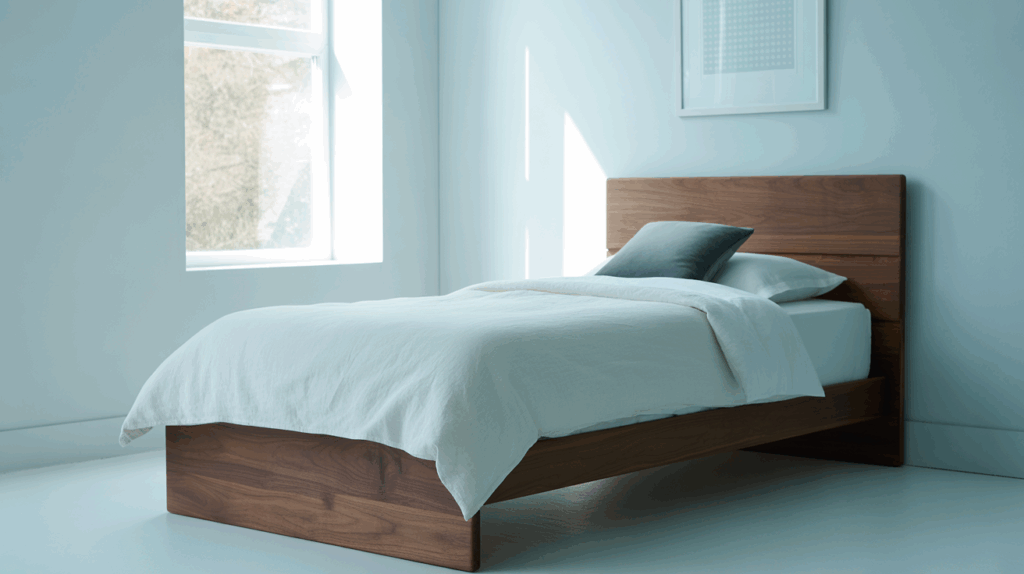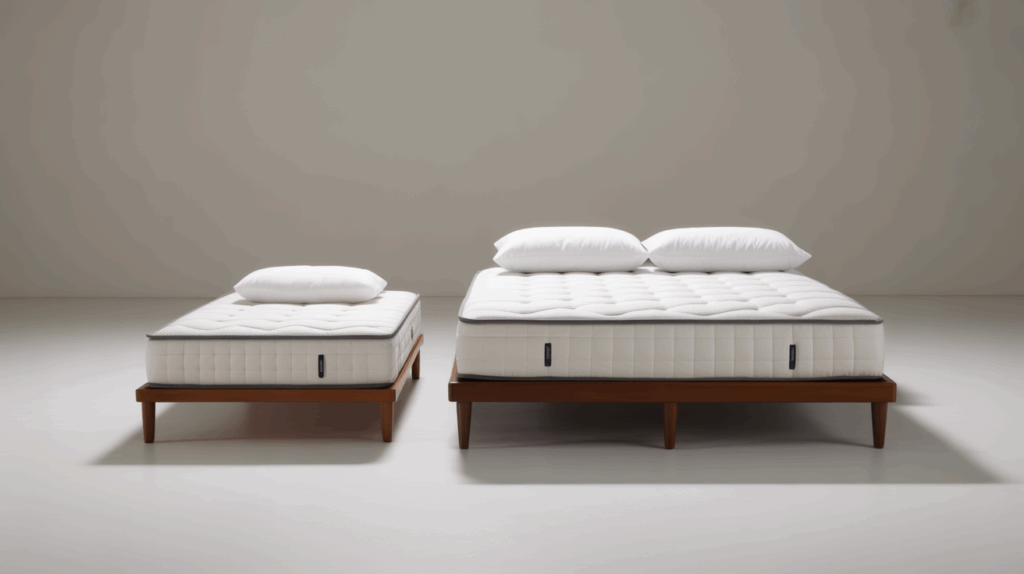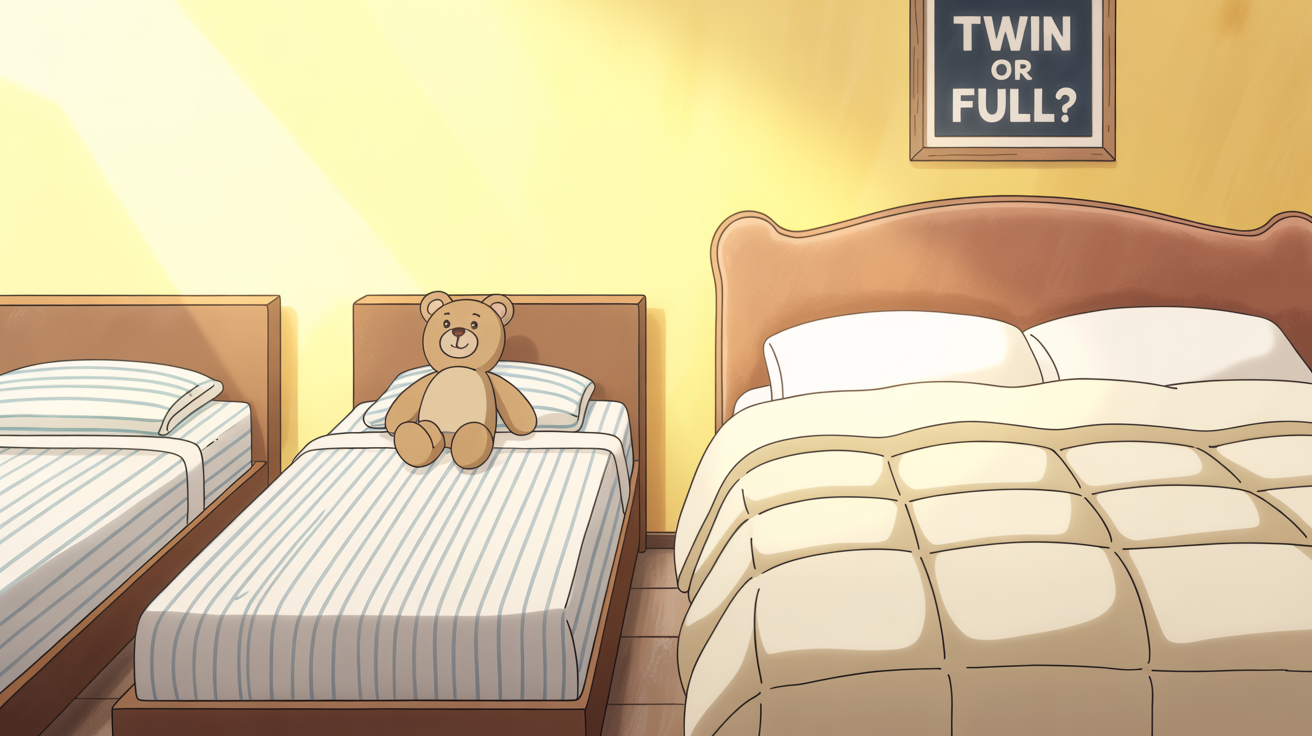Guiding the world of mattress sizes can feel like a complex puzzle, with twin and full mattresses representing two pivotal options for sleepers seeking comfort and practicality.
Size matters more than many realize—it’s not just about dimensions, but about creating a personal sleep sanctuary that adapts to individual needs.
Even when you’re furnishing a child’s bedroom, outfitting a guest room, or designing your own sleep space, understanding the nuanced differences between twin and full mattresses becomes crucial.
Each size tells a story of space, comfort, and lifestyle, promising to transform your sleeping experience from merely functional to truly restorative.
Understanding Mattress Dimensions
Choosing the right mattress size is crucial for achieving comfort, ensuring a good fit in your room, and maintaining optimal sleep quality.
Mattress dimensions vary to accommodate different needs, from individual sleepers to couples and families.
Twin and Twin XL sizes are great for solo sleepers and small spaces, offering compact widths but differing in length: Twin XL adds five extra inches.
Full and Full XL mattresses provide more width, making them suitable for single adults or teens who need extra space. Full XL also extends the length, accommodating taller individuals.
Knowing the exact measurements—like Twin at 38″ x 75″ or Full XL at 53″ x 80″—helps ensure your bed frame, room size, and bedding accessories align perfectly for a restful sleep experience.
How Long Is a Twin Bed?

A standard twin bed measures 75 inches in length, making it a compact and efficient choice for small bedrooms, guest rooms, or children’s spaces.
This size offers enough room for a single sleeper to rest comfortably while conserving space, especially in tight layouts. Its dimensions,38 inches wide and 75 inches long, make it ideal for bunk beds or dormitories where space is limited.
While suitable for most children and shorter adults, taller individuals might find a Twin XL more accommodating due to its extra five inches in length.
Understanding this dimension is crucial when planning room layouts or selecting bedding, as even a slight variation can significantly impact the fit and overall comfort of a sleeping arrangement.
Key Differences Between Twin and Full Mattresses

When deciding between a twin and full mattress, it’s important to consider more than just size.
These two mattress types cater to different needs, depending on the sleeper’s age, space requirements, room dimensions, and budget. Below is a comparison to help you make an informed choice.
| FEATURE | TWIN MATTRESS (38″ X 75″) | FULL MATTRESS (53″ X 75″) |
|---|---|---|
| Width & Surface Area | Compact, limited stretching space | 15″ wider; more room to move |
| Best for | Children, smaller teens | Teenagers, single adults needing space |
| Couples | Too narrow | Still tight, but possible for short-term use |
| Room Size Fit | Best for rooms ≥ 7′ x 10′ | Suited for rooms ≥ 10′ x 10′ |
| Cost | More budget-friendly for mattress and accessories | Generally higher; bedding and frames cost more |
| Accessory Availability | Widely available and economical | Readily available but moderately more expensive |
Choosing between twin and full depends on your space, comfort preferences, and who will be using the bed. Consider long-term needs to ensure the best value and fit.
Pros and Cons of Twin and Full Mattresses
Selecting between a twin and full mattress requires balancing comfort, space, and lifestyle needs. Both offer unique benefits depending on the user’s age, room size, and sleeping habits.
A twin bed is a space-saving solution often perfect for children or minimalists, while a full bed provides extra width for added comfort. Below is a breakdown of the pros and cons of each to help guide your decision.
Pros and Cons of a Twin Bed
A practical choice for kids, teens, or compact rooms—twin beds are affordable, easy to move, and widely available. However, they may feel too narrow for growing teens or adults.
Pros:
- Budget-friendly
- Lightweight and easy to transport
- Great for small rooms and bunk beds
- Bedding is inexpensive and easy to find
Cons:
- Not ideal for tall or broad individuals
- Limited space for movement
- Unsuitable for two people
Pros and Cons of a Full Bed
Full beds work well for solo adults or older teens who want more sleeping room. While they offer greater comfort, they come at a higher cost and can be trickier to move.
Pros:
- Extra 15 inches of width for stretching
- Suitable for guest rooms and single adults
- Better sleep quality for solo sleepers
Cons:
- More expensive than a twin
- Heavier and harder to maneuver
- May overcrowd smaller bedrooms
In conclusion, your choice between a twin and full bed depends on your space, budget, and who will be using the mattress. Consider both present and future needs to make the best investment.
Which Mattress is Right for You?
Choosing between a twin and full mattress depends on several personal factors like age, living space, and sleep habits. For younger children, a twin offers enough room and is easy to fit into shared kids’ rooms.
Teenagers or growing individuals may benefit from a full, which provides more width and long-term comfort. In studio apartments or guest rooms, both sizes can work: twins save space, while fulls offer more versatility.
First-time renters may prefer full beds for added comfort without overwhelming small spaces. Lastly, consider how you sleep: if you sprawl out or switch positions often, a full mattress gives you more flexibility.
For minimal sleepers or side sleepers, a twin may be a practical, space-saving choice.
Wrapping It Up
Ultimately, the choice between twin and full mattresses transcends mere measurements-it’s about crafting a sleep environment that nurtures your unique lifestyle.
From compact living spaces to growing bedrooms, these mattress sizes offer tailored solutions that balance comfort, budget, and personal preferences.
Your ideal mattress is more than a piece of furniture; it’s a personal investment in rest, growth, and well-being.
By carefully considering your current needs and future possibilities, you’ll find the perfect mattress that not only fits your space but also supports your travels toward better sleep and enhanced quality of life.








